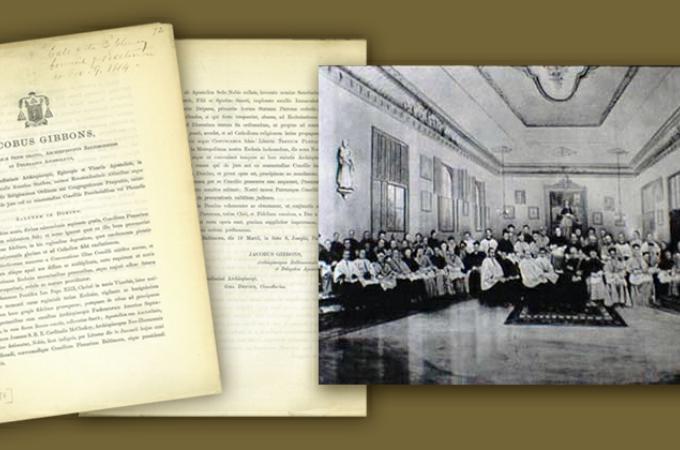The Third Plenary Council of Baltimore
On Sunday, Nov. 9, 1884, 14 archbishops, 57 bishops, six abbots, 31 superiors of religious orders, 11 seminary presidents, and 88 theologians convened for the opening of the Third Plenary Council of Baltimore. The first plenary council had been held in 1852, and the second in 1866, each evolving policy, governance and overall character of the Catholic Church in the United States.
A third plenary council had been discussed as early as 1881, but there was some resistance by the country's bishops. A brief glimpse into the debate is offered by a letter from Bishop Michael A. Corrigan, then-coadjutor of the Archdiocese of New York, to Archbishop John J. Williams of Boston, dated Jan. 27, 1882. Bishop Corrigan reveals that he is contacting Archbishop Williams at the behest of Cardinal John Gibbons of Baltimore, asking whether he thinks a meeting should take place. Cardinal Gibbons is of the opinion that it should not because preparations would take too long, and any effort to implement uniform policies across such a broad and diverse geographic area would be in vain; he instead suggests regional meetings as a potentially more effective alternative.
Bishop Corrigan also includes an excerpt from correspondence with the Holy See, which expressed its desire for a meeting to regulate relationships between priests and bishops and the training of priests in the United States, noting that while there were common practices, they needed to be debated and put into writing. With the bishops reluctant to call a national meeting, the Holy See took the initiative and in May 1883 called for a pre-conciliar meeting in Rome to take place the following November.
From Nov. 13 to Dec.13, representatives from Catholic dioceses in the United States met in Rome to lay the groundwork for the Third Plenary Council. Representatives from the Holy See expressed their desire for the Church in the United States to conform more closely with that of Europe, still seeing it very much as a mission territory, while those in opposition argued the Church there was founded under unique circumstances and thus required special considerations and rules.
There were also concerns about the authority of bishops in the United States, partly due to isolated complaints by priests, prompting the decree that each bishop form a board of diocesan consultors to advise him. Also discussed was the improvement of seminaries, giving pastors a voice in appointing new diocesan bishops and developing diocesan curiae.
Interestingly, Archbishop Williams who is most often characterized as a casual administrator, private in nature and soft spoken, appears to have been a major influence at the gathering, largely due to his status as one of the longest serving bishops in the United States at that time. Following the meeting, Cardinal Gibbons returned to Baltimore and prepared for the Plenary Council, where the decrees drafted in Rome would be debated, revised and then resubmitted to Rome for final approval.
In addition to the aforementioned subjects, Catholic education received much attention, with nearly a quarter of the decrees addressing this issue. Reforms included standardizing the course of study at major seminaries to two years of philosophy followed by four of theology. Of lasting significance was the idea of founding a principal seminary in the United States, leading to the establishment of the Catholic University of America several years later.
Other decrees insisted that each parish have a parochial school, and that each diocese appoint a board of examiners to evaluate teaching candidates and a commission to conduct periodic inspections of each school. Parents, it was said, would be required to send their children to the school unless an adequate Catholic education could be provided at home.
The council concluded on Dec. 7, 1884, and the decrees approved by Rome in September 1885. This was followed by a diocesan synod in Boston on June 28, 1886, the fourth in this diocese, to approve and implement the decrees at a local level.
While the plenary councils of Baltimore may at first appear bureaucratic in nature, their approval and implementation via diocesan synods meant that they had a very practical and real impact at the local level. The changes approved at these councils would have reached parishioners and the communities in which they lived, shaping their interactions with the Catholic Church, and in a broader context are noteworthy for their role in the evolution of the Catholic Church in the United States.
The decrees passed by the Council were published in Latin, and are titled "Acta et Decreta Concilli Plenarii Baltimorenses Tertti." The text can be found online and in various libraries.
- Thomas Lester is the archivist of the Archdiocese of Boston.



















